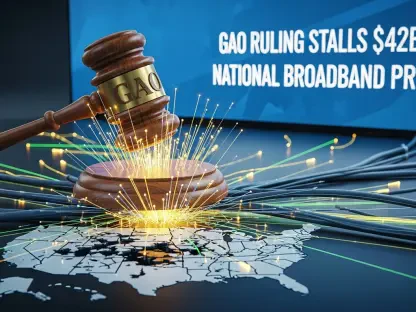In an era where mobile video consumption dominates digital traffic, the challenge of delivering high-quality content on the go has never been more pressing, with recent data from Ericsson highlighting that video accounts for nearly 74% of mobile data usage. This places unprecedented strain on mobile network operators (MNOs) and content providers to ensure seamless streaming without escalating costs. The spotlight at IBC2025 falls on Versatile Video Coding (VVC), a groundbreaking compression standard designed to transform video delivery at the network edge. By significantly reducing bandwidth requirements while preserving stunning visual clarity, VVC offers a promising solution to enhance the quality of experience (QoE) for users worldwide. Coupled with advancements in edge computing and connectivity technologies like 5G, this innovation is set to redefine how mobile video ecosystems operate. This article delves into the surging demand for mobile content, the technical prowess of VVC, and the strategic approaches shaping its adoption across the industry.
Addressing the Surge in Mobile Video Demand
The explosion of mobile video consumption continues to reshape the digital landscape, with smartphones, tablets, and IoT devices all competing for limited bandwidth in an increasingly crowded network environment. During peak usage periods, such as live sports broadcasts or in densely populated areas like transit hubs, users often face frustrating delays as latency spikes and available bandwidth per device shrinks. This scenario reveals a critical need for innovative technologies that can keep pace with skyrocketing user expectations. The pressure is not just on maintaining connectivity but on delivering content that meets modern standards of quality, ensuring viewers are not left with buffering icons during crucial moments. As mobile networks grapple with these challenges, the industry is turning to solutions that can alleviate congestion without requiring massive infrastructure investments, setting the stage for transformative approaches at the edge.
Consumer expectations have evolved dramatically, with 720p and 1080p resolutions now considered the baseline for acceptable mobile viewing, a significant shift from the lower-quality 540p streams of the past. This demand for high-definition content spans various applications, from gaming and live sports to immersive experiences like augmented reality (AR) and virtual reality (VR), all of which require substantial bandwidth. Meeting these expectations is no longer optional but a competitive necessity for content providers aiming to retain user engagement. The strain on networks during high-traffic scenarios underscores the urgency of adopting advanced compression and delivery mechanisms that can sustain QoE under pressure. As viewers grow accustomed to crisp, uninterrupted streams, the role of cutting-edge standards becomes paramount in bridging the gap between demand and network capacity, paving the way for innovations that promise to enhance mobile video delivery.
Unveiling the Power of Versatile Video Coding
Versatile Video Coding (VVC) stands out as a revolutionary tool in the quest to optimize mobile video streaming, offering remarkable compression efficiency that slashes bitrate needs by 20-30%, and in some cases up to 50% compared to High Efficiency Video Coding (HEVC). This capability ensures smoother playback, faster load times, and minimal interruptions, even in environments where bandwidth is scarce. For end users, the impact is clear: a superior viewing experience that maintains high-quality visuals without the frustration of buffering, whether watching a live event or streaming on a crowded network. VVC’s ability to deliver such results positions it as a vital asset in addressing the challenges of modern mobile video consumption, promising to elevate QoE across diverse usage scenarios and device types, all while adapting to the constraints of real-world network conditions.
Beyond enhancing user satisfaction, VVC provides substantial benefits to mobile network operators and content providers by significantly reducing the burden on network infrastructure. Lower bandwidth consumption directly translates to decreased operational expenses, a critical advantage in an industry where scaling delivery often comes with hefty costs. Demonstrations by industry experts, such as Yan Ye from Alibaba’s DAMO Academy, have showcased VVC’s impressive performance, achieving over 120 frames per second on older devices with minimal resource usage. This adaptability to existing hardware highlights VVC’s potential to be deployed widely without necessitating expensive upgrades. For stakeholders, the financial relief combined with improved service quality creates a compelling case for embracing this technology, marking it as a dual-purpose solution that addresses both economic and experiential demands in the mobile video space.
Leveraging Edge Computing for Optimal Delivery
Edge computing has emerged as a cornerstone in refining mobile video delivery by positioning processing power closer to the end user, thereby cutting down latency in high-traffic situations. This approach proves especially effective during peak demand periods, where traditional centralized networks often falter under the weight of simultaneous streams. When integrated with VVC’s advanced compression, edge computing ensures that the critical “last mile” of delivery is both swift and dependable, enhancing reliability for users in challenging environments. The synergy between these technologies tackles persistent network constraints at the edge, where computational resources and bandwidth are frequently limited. By decentralizing data processing, this strategy not only boosts streaming performance but also mitigates the risk of bottlenecks, offering a robust framework for managing the complexities of modern mobile video traffic.
The strategic deployment of VVC alongside edge computing reflects a practical mindset, focusing on compatibility with existing systems rather than a complete overhaul of current infrastructure. Unlike a disruptive replacement of established codecs such as HEVC or AV1, VVC is engineered to coexist, supporting a diverse array of legacy and contemporary devices through software-based implementations. Insights from industry leaders like Aytac Biber of Qualcomm emphasize the ease of integration, noting that this approach enables rapid rollout without the need for costly hardware changes. Such flexibility is crucial for streaming platforms and broadcasters aiming to optimize spectrum efficiency and cater to a broad audience. This incremental adoption strategy ensures that the benefits of enhanced video quality reach users sooner, fostering a smoother transition to next-generation standards across the mobile video ecosystem.
Future Pathways for Mobile Video Innovation
Looking ahead, the adoption of VVC is poised to expand significantly, driven by its proven efficiency in reducing bandwidth strain while upholding high-quality standards like 1080p. For mobile network operators, the cost savings from lighter network loads present a strong incentive to integrate this technology into their operations over the coming years, potentially from 2025 to 2027. Content distributors, including broadcasters and streaming services, also stand to gain by leveraging VVC to offer more channels or superior content within existing spectrum constraints. The ability to cater to growing consumer demand for premium formats, such as live sports and immersive media, further solidifies VVC’s role as a transformative force. As deployment gains momentum, the focus will likely shift toward refining software solutions to ensure seamless compatibility across an even wider range of devices.
Reflecting on the strides made, the journey of integrating VVC into the mobile video landscape reveals a thoughtful balance between innovation and practicality. The collaboration between edge computing and VVC addresses critical pain points like latency and bandwidth scarcity, setting a new benchmark for QoE in high-demand scenarios. Industry discussions at IBC2025 underscore a shared optimism among experts about the scalability of this technology, with software-based approaches ensuring accessibility even on older hardware. Broadcasters and streaming platforms recognize the potential to maximize resources, delivering enriched content to diverse audiences. Moving forward, the emphasis should be on accelerating partnerships between technology providers and network operators to drive adoption, while continuously monitoring user feedback to fine-tune performance. These steps will help solidify VVC’s impact, ensuring mobile video delivery evolves to meet future challenges with agility and precision.









